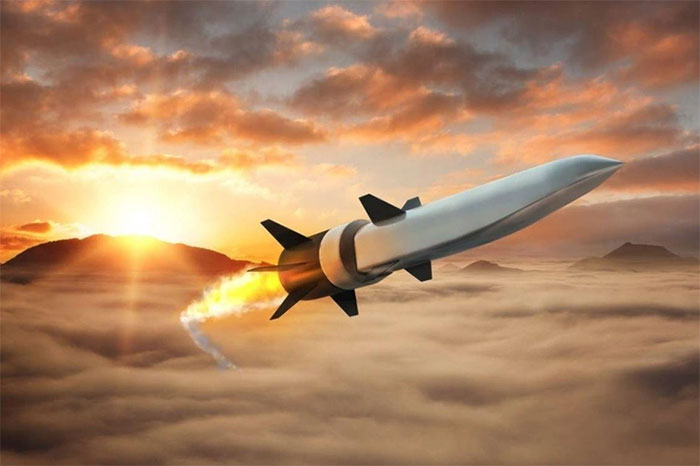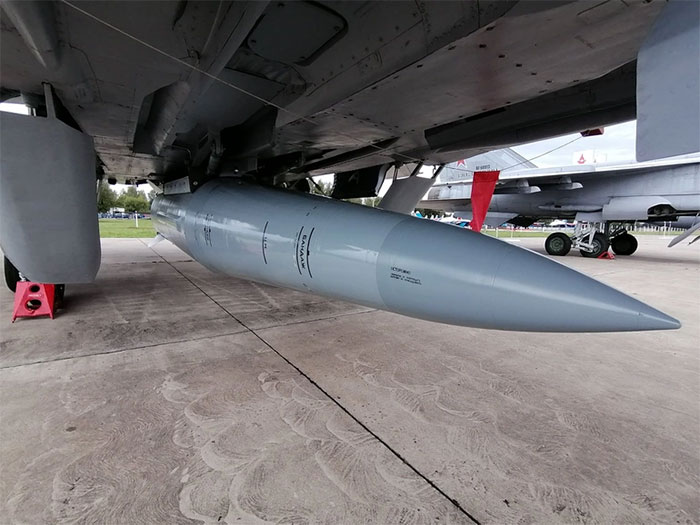How do hypersonic missiles work?
The famous Kinzhal supersonic missile of the Russian military with powerful destructive power, can reach a speed of 12 times the speed of sound, and an operating range of up to 3,000 km.
Russia has never used this type of ballistic missile before in the two previous conflicts in Syria and Ukraine, although it has deployed it several times in exercises since its successful test in 2018.

Hypersonic missiles are among the high-tech weapons that Russia showed off in 2018.
How does a hypersonic missile work?
Kinzhal hypersonic missiles were among a number of high-tech weapons that Russia showed off in 2018. Russian President Vladimir Putin at the time called them "the perfect weapon" when deployed on Russian planes. , such as the Mig 31K.
According to Russian media sources, the Kinzhal missile can rapidly accelerate to more than four times the speed of sound (equivalent to 5,000 km/h) immediately after launch, and reach speeds 12 times faster than the speed of sound. bar (about 14,800 km/h) with an operating range of up to 3,000 km.
By definition, anything faster than "Mach-5" - that is, 5 times the speed of sound, is considered "ultrasonic". It is known that significant physical changes in the texture of the supersonic airflow are required to achieve such speeds. This was once seen as a challenge for aerospace engineers in deploying rockets to launch into space.
According to Southfront, hypersonic missiles have two variants, including: supersonic cruise missiles and supersonic flying vehicles.
- A supersonic cruise missile is a type that can reach its target with the help of a high-speed jet engine, or ballistic missile - as opposed to a traditional intercontinental ballistic missile (ICBM). Use gravity to reach the target.
- A hypersonic vehicle is a type of missile that is launched into space in an arc trajectory, where warheads are launched and fall into the atmosphere at supersonic speeds, enough to overcome missile defense systems. existing fire.
What is a hypersonic missile built for?
With a payload of about 1,000 pounds (480 kg), Kinzhal missiles are typically high-impact warheads. However, this type of missile can also be equipped with a nuclear warhead of the same size, with a destructive power many times stronger, equivalent to 100-500 kilotons of TNT.
The idea behind the design of the Kinzhal missiles is that they will travel so fast that it is nearly impossible to track and intercept. They are also said to be able to perform flexible maneuvers when flying at supersonic speeds, helping to evade enemy missile defense systems.
The rockets' very high speed also makes them capable of penetrating heavily armored targets, such as an underground arsenal in western Ukraine, which is believed to have been the target of the latest attack by the US Army. Russia made.

A MiG-31 fighter jet launches a Kinzhal hypersonic missile during a test at an undisclosed location in Russia in 2018 (Image: AP).
What is the difference between subsonic, ultrasound and supersonic?
In the future, a country's military superiority will depend in part on the speed and duration of the missile, as well as the means of flight. In which, there are 3 common levels of speed convention, which are subsonic (Subsonic), ultrasonic (Supersonic), and supersonic (Hypersonic).
Most of the famous missiles today are of type 1, which is subsonic. Such as the American Tomahawk cruise missile, France's Exocet or India's Nirbhay. They move at an average speed of Mach-0.9 (about 1134 km/h).
Subsonic missiles are slow and easy to intercept, but they still play an important role in the modern battlefield. Not only are they significantly cheaper to manufacture because of the technological challenges that have been overcome and mastered, but they also provide another added value, which is time.
In particular, it is precisely the relatively low speed of subsonic missiles that will allow senior military decision-makers more time to decide whether to continue or abandon an arrow attack. fire.

Close-up of Kinzhal hypersonic missile - famous weapon of the Russian army with powerful destructive power
The faster, supersonic, allows the missile to exceed the speed of sound (Mach-1), but not faster than Mach-3. The most famous supersonic missile is the Indian/Russian BrahMos, currently the fastest operating hypersonic missile with a speed of about 3,379 km/h.
The most advanced today, supersonic, are conventional missiles that exceed the speed of Mach-5 (6,115 km/h) and are five times faster than the speed of sound. World powers including the US, Russia, India and China have spent years researching hypersonic missiles.
The missile is said to be so fast that the air pressure in front of the warhead forms a plasma cloud as it moves, allowing it to absorb radio waves and make it invisible to active radar systems.
While the US missile interceptor system needed a reaction time of 8-10 seconds to intercept the attacks, the Russian Kinzhal missile flew at least 20km, making it difficult for the interceptor missile to fly enough. fast to catch up.
According to Popular Mechanics, even if an American ship detected a Kinzhal missile from 100km away, they would have only one minute to decide what to do with it.
However, there are many technological hurdles to overcome, particularly regarding the maintenance of combustion inside the rocket system, as well as the ability to withstand extreme temperatures at supersonic speeds.
- How does cruise missiles work?
- Top 10 most terrifying intercontinental missiles in the world
- Russian intercontinental missiles were destroyed by human error
- 8 most terrifying ground attack missiles
- The deadly elements of cruise missiles or the use of shot-down rifles Tomahawk
- Surprise with the 'ancestor' of all intercontinental ballistic missiles
- Astronauts will fly to space by ordinary airports
- Inventing missiles
- Things to know about Buk missiles
- Where does the new Chinese missile fly?
- China is about to have nuclear missiles that can
- America develops cruise missiles in formation
 The most famous scientific failures in history
The most famous scientific failures in history Mysterious genius mechanic and the machine froze time
Mysterious genius mechanic and the machine froze time The son carries the 'bad gene' of genius Albert Einstein
The son carries the 'bad gene' of genius Albert Einstein Isaac Newton
Isaac Newton Did humanity just witness its first space battle?
Did humanity just witness its first space battle?  How does the Stinger missile work?
How does the Stinger missile work?  Close up of the missile journey from the launch pad, move and hit the target
Close up of the missile journey from the launch pad, move and hit the target  Which Israeli naval light guard ships are equipped with advanced weapons?
Which Israeli naval light guard ships are equipped with advanced weapons?  Discover the secret bases of the Soviet Union
Discover the secret bases of the Soviet Union  Russia successfully tested missiles' unable to intercept
Russia successfully tested missiles' unable to intercept 